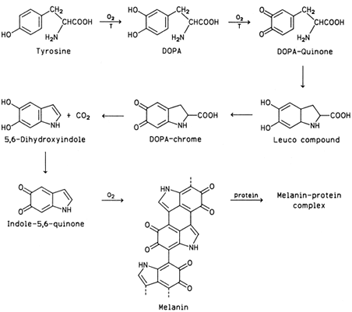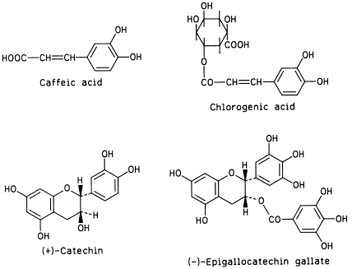Enzymatic Browning
Several enzymes may initiate reactions that eventually
produce brown colors in foods. For example, the action
of ascorbate oxidase on ascorbic acid or of lipoxidase on
lipids leads to carbonyl products that may either polymerize
or react with amino compounds and form brown products.
Phenolase (or phenol oxidase), however, is the principal
browning enzyme. This enzyme oxidizes
o-diphenols
to
o-quinones, which, by nonenzymatic processes, are ultimately
converted to brown polymers known as melanins.
Melanins are formed in both animal and plant tissues. A
typical substrate of phenolase in animals is tyrosine. This
amino acid is converted to melanin by a series of reactions,
some of which are shown in Fig. 12.
In dark hair, skin, eyes, and other animal tissues,
melanin is attached to proteins. Tyrosine is also a phenolase
substrate in plant tissues (e.g., potatoes), but odiphenols
and polyphenols are by far the most common
substrates of enzymatic browning in foods of plant origin.
The following phenolic compounds have been associated
with enzymatic browning in some foods: chlorogenic acid,
caffeic acid, and catechin in apples, apricots, peaches, and
pears; 3,4-dihydroxyphenylethylamine in bananas; (−)-epicatechin, (+)-catechin, (+)-gallocatechin, and (−)-epigallocatechin galate in tea leaves and cocoa beans;
catechins in grapes; and tyrosine and chlorogenic acid
in potatoes. The structures of four of these phenolics are
shown in Fig. 13.
 |
| Figure 12 Conversion of tyrosine to melanin, catalyzed in part by tyrosinase (T). DOPA, Dihydroxyphenylalanine.
Only part of melanin is shown. |
 |
| Figure 13 Four phenolic compounds involved in enzymatic
browning. |
Many fresh fruits and vegetables brown slowly as they
senesce. The enzymatic browning of these commodities
is more rapid when they are subjected to processing, such
as the pressing of apples in making cider or the peeling
and cutting of potatoes in preparing potato products. Since
enzyme, substrate, and oxygen must all be present for the
development of this type of browning, elimination of any
one of the three agents will prevent the browning. Heat
inactivation of the enzyme, the exclusion of oxygen (by
keeping the commodity under water or packaging it under
vacuum or inert gas), and the selection of varieties poor in
substrate content or enzyme activity are ways of preventing
this discoloration. Also, storage at lowtemperature and
the addition of sulfur dioxide, ascorbic acid, citric acid,
sodium chloride, or combinations of these compounds will
inhibit browning.






